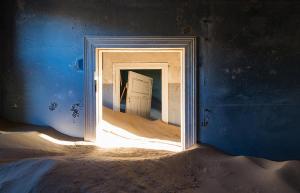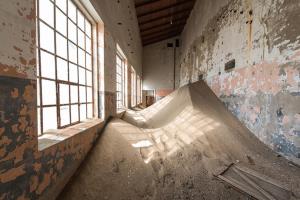What happens after we’re gone?
It’s a question that plagues generation after generation. Humans have always been concerned about the legacy we’re leaving behind. Will we be remembered for more than global warming? Will our contributions matter to anyone but our relatives? Will the people we respect miss our presence?
It’s hard to know, but photographer Romain Veillon makes a beautiful stab at it.
The artist spent a week in a town called Kolmanskop in the Namibian desert. Now abandoned, the village was once home to German diamond miners who settled in the area in 1908. The article that led me to Veillon’s work explains that settlers said diamonds were so easy to find, they sparkled in the sand at night. The town grew and along with it, the accouterment of settlement: a bowling alley, a casino, an ice factory. The town hospital was home to Africa’s first x-ray machine, which Veillon says was used mostly to make sure miners weren’t swallowing their findings.
But with World War I came a decrease in diamond prices, and by 1954, Kolmanskop was abandoned.
Veillon’s series of photographs, titled “Les sables du temps” (“The Sands of Time”), shows the reality of the town as it now stands: A collection of buildings filling slowly with sand. Once brightly painted rooms are now peeling walls boxing in mountains of desert.
The results are hauntingly beautiful, dreamlike even. The play of light on the sand is almost welcoming, but it’s clear that humans are no longer welcome.
These works demonstrate that the fleeting constructions of man are no match for the quiet strength of nature. Though humanity has tried to impose its will in this quiet corner of Namibia, the earth — which has infinite time — simply outlasted the settlers and took back control.
At first, I thought the images were a little disheartening, a reminder that no matter how hard we try, we ultimately fade into irrelevance.
Then, I went to Veillon’s website. He explains that to him, the photographs capture the inevitable passing of time. The fact that one day there will be nothing reminds us of the importance of enjoying life right now.
Maybe we won’t be remembered. Maybe our contributions won’t mean much. Maybe the people we respect will slowly forget us. But right now, we’re here, and Veillon’s photographs urge us to make the most of it.

